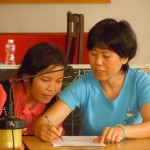CHICAPS (Chinese Cervical Cancer Prevention Study)
Over the past several years the focus of cervical cancer screening programs designed for mass screening and able to reach the underserved, have ranged from complex infrastructure demanding cytology (Pap) based efforts, to very low tech unaided visual inspection programs (using 5% acetic acid). Then molecular testing (detection of high-risk HPV) moved to center stage with increased sensitivity and an excellent negative predictive value. Now with the development of relatively low-cost, low tech, rapid (2hr, 20-90 batch) HPV testing (CareHPV), algorithms are being developed to try to deliver care to the underserved. Due to recent findings based on our self-sampling work over the past 16 years, recent developments in solid transport media (specimen transport cards), and our enlightening experience (in SHENCCAST II) with a low cost, high throughput, high tech HPV testing system, we have designed this study to further explore these technologies and their cost-effective implementation for world-wide cervical cancer control. CHICAPS builds upon the work we have been doing in the PERCAPS project in Peru
The Primary Objective
1. To develop and implement a community based model for cervical cancer prevention that allows the communities to manage the screening and the healthcare system to focus resources on evaluation and management of the positives.
Method: Using self-sampling and the concepts founded in Community Based Participatory Research (CBPR), we progressively developed a model to efficiently reach the women, especially rural communities; and collect the volume of samples needed to support high throughput centralized low cost per case processing
Results: 8382 eligible women, ages 35 to 59, in 130 rural communities participated. The screening was organized by the local government administration and conducted by the community leaders (CL). The model used was progressively designed through detailed assessment of key elements at 6 decision points in 26 workshops that were used to train the CLs and the local promoters. The communities were able to accurately conduct the screening; in the final model a local medical worker conducted a 50-minute workshop featuring instructional posters and structured role-play. A manual and a workshop DVD were created for distribution to and implementation by local governments. The average callback rate was 84.3%, without involvement of the local doctors in the management of the positives.
Conclusion: An efficient community based model capable of massive screening events was developed. We believe the callback rate will be further improved when local doctors are trained in the management of the positives. Many elements impact coverage and further research is needed to define the influence of the identified key variables.
Secondary Objectives
1. Acquire increased experience using solid transport media cards with the rapid high risk PCR based HPV assay using Mass Spectrometry (MALDI-TOF) in a cervical cancer screening program.
- 2. Development of an effective specimen transport system (air, truck, etc).
3. Determine the true impact of histopathological verification of disease in the screen, triage, and treat model. As of this writing we have just began the 2 year follow-up which includes the evaluation (at 6 months and 2 years) of a randomization for evaluation and management.
Photos
Please click on any image to zoom, then use < > or arrow keys to navigate.
REFERENCES
1. Vaccine. 2009 Feb 18;27(8):1210-5. doi: 10.1016/j.vaccine.2008.12.020. Epub 2009
Jan 9.
Knowledge and attitudes about human papillomavirus (HPV) and HPV vaccines among women living in metropolitan and rural regions of China.
Li J(1), Li LK, Ma JF, Wei LH, Niyazi M, Li CQ, Xu AD, Wang JB, Liang H,
Belinson J, Qiao YL.
Author information:
(1)Department of Cancer Epidemiology, Cancer Institute, Chinese Academy of
Medical Sciences, Beijing 100021, China.
Infection with the human papillomavirus (HPV) is one of the most common sexually
transmitted infections and causes virtually all cervical cancer globally. The
recent development of two safe and clinically effective vaccines against HPV is
a promising step towards lowering cervical cancer rates in the future. What
Chinese women think about HPV and the vaccines remains unknown. We undertook a
population-based survey, which was embedded in a cervical cancer screening
project and was designed to assess women’s knowledge about HPV and their
acceptability to the vaccines. We found that only 15.0% of women in our study
reported to have ever heard of HPV, and this knowledge differs by rural (9.3%)
and metropolitan areas (21.6%) and also by education. Most (84.6%) participants
were willing to be vaccinated if HPV vaccine became available to them. The
present study documents ways in which women learn about HPV and indicates the
potential barriers and success of introducing HPV vaccine to China.
DOI: 10.1016/j.vaccine.2008.12.020
PMID: 19135493 [Indexed for MEDLINE]
2. Am J Epidemiol. 2009 Sep 15;170(6):708-16. doi: 10.1093/aje/kwp188. Epub 2009
Aug 19.
Human papillomavirus testing for cervical cancer screening: results from a 6-year prospective study in rural China.
Shi JF(1), Belinson JL, Zhao FH, Pretorius RG, Li J, Ma JF, Chen F, Xiang W, Pan
QJ, Zhang X, Zhang WH, Qiao YL, Smith JS.
Author information:
(1)Department of Cancer Epidemiology, Cancer Institute/Hospital, Chinese Academy
of Medical Sciences, Peking Union Medical College, Beijing, People’s Republic of
China.
Long-term follow-up evaluations of cervical screening approaches are limited in
low-resource areas. This prospective study assessed the risk of future cervical
intraepithelial neoplasia grade 2 or worse (CIN2+) associated with baseline
human papillomavirus (HPV) and cytologic status. In rural China, 1,997 women
were screened with 6 screening tests, including colposcopic evaluations, and
underwent biopsies in 1999. In December 2005, 1,612 women with cervical
intraepithelial neoplasia grade 1 or less at baseline were rescreened by visual
inspection, liquid-based cytology, and HPV-DNA testing. All women underwent
colposcopy at follow-up, with biopsies taken from women with visually apparent
lesions or cytologic abnormalities. Twenty women developed incident CIN2+. The
crude relative risk of CIN2+ for baseline HPV-positive women was 52 (95%
confidence interval: 12.1, 222.5). The crude relative risk of CIN2+ was 167 (95%
confidence interval: 21.9, 1,265) for baseline and follow-up repeatedly
HPV-positive women compared with repeatedly HPV-negative women. Among 1,374
baseline HPV-negative women, 2 and no incident CIN2+ cases were detected in
baseline cytologically normal and abnormal subgroups, respectively. Among 238
baseline HPV-positive women, 6 of 18 incident cases of CIN2+ developed in the
cytologically normal group. This study demonstrates that a single oncogenic
HPV-DNA test is more effective than cytology in predicting future CIN2+ status.
DOI: 10.1093/aje/kwp188
PMID: 19692327 [Indexed for MEDLINE]
3. Int J Gynecol Cancer. 2010 Aug;20(6):1006-10. doi: 10.1111/IGC.0b013e3181e73092.
SNIPER: a novel assay for human papillomavirus testing among women in Guizhou, China.
Belinson SE(1), Wulan N, Li R, Zhang W, Rong X, Zhu Y, Wu R, Belinson JL.
Author information:
(1)Preventive Oncology International, Inc, Cleveland Heights, Ohio 44118, USA.
seb@poiinc.org
OBJECTIVE: Clinically validate the SNIPER human papillomavirus (HPV) DNA assay
for the detection of cervical intraepithelial neoplasia (CIN)2 or higher and
CIN2 or higher in a prospective cross-sectional screening study in Guizhou
Province, China.
METHODS: Between March and April, 2008, 1000 nonpregnant women aged 30 or older
were recruited in Guizhou Province, China. Women positive by SNIPER or
cytological examination were requested to return for follow-up. A biopsy of all
colposcopically detected abnormalities was performed by quadrant. In normal
quadrants, biopsies were obtained at the squamocolumnar junction (2-, 4-, 8-,
and 10-o’clock positions depending on the quadrant). Samples were placed in 2 mL
of saline solution and maintained between 2 degrees C and 30 degrees C for up to
1 week. One milliliter of this suspension was then prepared and tested. For
polymerase chain reaction amplification, a pool of HPV primers was designed to
amplify HPV DNA from 13 high-risk-HPV genotypes (types 16, 18, 31, 33, 35, 39,
45, 51, 52, 56, 58, 59, and 68). Test characteristics were calculated according
to standard definitions.
RESULTS: One thousand women were screened; 175 tested HPV positive, 36 women
tested negative but had positive Papanicolaou test results. All but 21 (90%)
returned for follow-up. Median age and proportions having CIN2 or higher and
CIN3 or higher differed by HPV status. Twenty-five women had CIN2 or higher and
16 had CIN3 or higher. The SNIPER assay was 93.3% and 94% sensitive and 86% and
85% specific for the detection of CIN2 or higher and CIN3 or higher,
respectively. The positive predictive value was 17.4 % and 9.9% for CIN2 or
higher and CIN3 or higher, respectively. Negative predictive value approached
100% for CIN2 or higher and CIN3 or higher.
CONCLUSION: The SNIPER assay is functionally competitive and in terms of cost
holds an advantage over Hybrid Capture 2 in a Chinese healthcare market, and
potentially others, around the world.
DOI: 10.1111/IGC.0b013e3181e73092
PMCID: PMC2971549
PMID: 20683409 [Indexed for MEDLINE]
4. J Natl Cancer Inst. 2012 Feb 8;104(3):178-88. doi: 10.1093/jnci/djr532. Epub
2012 Jan 23.
Pooled analysis of a self-sampling HPV DNA Test as a cervical cancer primary screening method.
Zhao FH(1), Lewkowitz AK, Chen F, Lin MJ, Hu SY, Zhang X, Pan QJ, Ma JF, Niyazi
M, Li CQ, Li SM, Smith JS, Belinson JL, Qiao YL, Castle PE.
Author information:
(1)Department of Epidemiology, Cancer Institute and Hospital, Chinese Academy of
Medical Sciences and Peking Union Medical College, Beijing, People’s Republic of
China.
Comment in
J Natl Cancer Inst. 2012 Feb 8;104(3):166-7. doi: 10.1093/jnci/djr544.
BACKGROUND: Worldwide, one-seventh of cervical cancers occur in China, which
lacks a national screening program. By evaluating the diagnostic accuracy of
self-collected cervicovaginal specimens tested for human papillomavirus (HPV)
DNA (Self-HPV testing) in China, we sought to determine whether Self-HPV testing
may serve as a primary cervical cancer screening method in low-resource
settings.
METHODS: We compiled individual patient data from five population-based cervical
cancer-screening studies in China. Participants (n = 13 140) received Self-HPV
testing, physician-collected cervical specimens for HPV testing (Physician-HPV
testing), liquid-based cytology (LBC), and visual inspection with acetic acid
(VIA). Screen-positive women underwent colposcopy and confirmatory biopsy. We
analyzed the accuracies of pooled Self-HPV testing, Physician-HPV testing, VIA,
and LBC to detect biopsy-confirmed cervical intraepithelial neoplasia grade 2 or
more severe (CIN2+) and CIN3+. All statistical tests were two-sided.
RESULTS: Of 13 004 women included in the analysis, 507 (3.9%) were diagnosed as
CIN2+, 273 (2.1%) as CIN3+, and 37 (0.3%) with cervical cancer. Self-HPV testing
had 86.2% sensitivity and 80.7% specificity for detecting CIN2+ and 86.1%
sensitivity and 79.5% specificity for detecting CIN3+. VIA had statistically
significantly lower sensitivity for detecting CIN2+ (50.3%) and CIN3+ (55.7%)
and higher specificity for detecting CIN2+ (87.4%) and CIN3+ (86.9%) (all P
values < .001) than Self-HPV testing, LBC had lower sensitivity for detecting
CIN2+ (80.7%, P = .015), similar sensitivity for detecting CIN3+ (89.0%, P =
.341), and higher specificity for detecting CIN2+ (94.0%, P < .001) and CIN3+
(92.8%, P < .001) than Self-HPV testing. Physician-HPV testing was more
sensitive for detecting CIN2+ (97.0%) and CIN3+ (97.8%) but similarly specific
for detecting CIN2+ (82.7%) and CIN3+ (81.3%) (all P values <.001) than Self-HPV
testing.
CONCLUSIONS: The sensitivity of Self-HPV testing compared favorably with that of
LBC and was superior to the sensitivity of VIA. Self-HPV testing may complement
current screening programs by increasing population coverage in settings that do
not have easy access to comprehensive cytology-based screening.
DOI: 10.1093/jnci/djr532
PMCID: PMC3274511
PMID: 22271765 [Indexed for MEDLINE]
5. PLoS One. 2020 May 1;15(5):e0232117. doi: 10.1371/journal.pone.0232117.
eCollection 2020.
The application of BMRT-HPV viral load to secondary screening strategies for cervical cancer.
Duan L(1)(2), Du H(1)(2), Wang C(1)(2), Huang X(1)(2), Qu X(3), Shi B(4), Liu
Y(5), Zhang W(6), Duan X(7), Wei L(8), Belinson JL(9)(10), Wu R(1)(2).
Author information:
(1)Department of Gynecology and Obstetrics, Peking University Shenzhen Hospital,
Shenzhen, China.
(2)Shenzhen Key Laboratory on Technology for Early Diagnosis of Major
Gynecological Diseases, Shenzhen, PR,China.
(3)Sanming Project of Medicine in Shenzhen Peking University Shenzhen Hospital,
Shenzhen, China.
(4)Department of Gynecology and Obstetrics, The Second Hospital of Hebei Medical
University, Hebei, China.
(5)Department of Gynecology and Obstetrics, Huashan Hospital North, Fudan
University, Shanghai, China.
(6)Department of Gynecology and Obstetrics, Zhongnan Hospital of Wuhan
University, Wuhan, China.
(7)Department of Gynecology and Obstetrics, Capital Medical University Beijing
Tongren Hospital, Beijing, PR, China.
(8)Department of Gynecology and Obstetrics, Peking University People’s Hospital,
Beijing, PR, China.
(9)Preventive Oncology International, Cleveland Heights, OH, United States of
America.
(10)Women’s Health Institute, Cleveland Clinic, Cleveland, OH, United States of
America.
OBJECTIVE: Evaluate the significance of BMRT HPV assay viral load and its
performance for secondary screening.
METHODS: BMRT-HPV reports type-specific viral loads/10,000 cells. We tested
1,495 physician collected, stored specimens from Chinese Multiple-center
Screening Trial (CHIMUST), that were positive by Cobas, SeqHPV, and/or Cytology
(≥LSIL); and 2,990 age matched, negatives in a nested case control study. We
explored the relationship between BMRT HR-HPV viral load and cervical lesions,
determined alternative CIN2+ cut-points by ROC curve, and evaluated BMRT HR-HPV
for primary / secondary cervical cancer screening.
RESULTS: The viral loads of HPV16/18, 12 other subtypes HR-HPV and 14 HR-HPV
were statistically different in all grades of cervical lesions (P<0.05, among
which HPV16, 33 and 58 showed the strongest relationship (P<0.01). The viral
load of HR-HPV also increased with the grade of cervical lesions (P<0.05). The
sensitivity for CIN2+ and CIN3+ of BMRT was comparable to Cobas (92.6% vs 94.3%,
100% vs 100%, P>0.05), specificity was higher than Cobas (84.8% vs 83.3%, 83.5%
vs 82.0%, P<0.001). When using HPV16/18 viral load(log cut-point ≥3.2929), plus
the viral-load of 12 other subtypes (log cut-point ≥3.9625) as secondary triage,
compared with Cobas HPV16/18+ plus cytology ≥ASC-US as triage, the sensitivities
for CIN2+ and CIN3+ were similar (P>0.05). However, the BMRT HR-HPV viral load
combined with subtypes did not require cytology.
CONCLUSION: BMRT is as sensitive as Cobas4800 for primary cervical cancer
screening. BMRT HR-HPV viral load combined with subtypes can be used as a
secondary strategy for cervical cancer screening, especially for areas with
insufficient cytological resources.
DOI: 10.1371/journal.pone.0232117
PMCID: PMC7194433
PMID: 32357165 [Indexed for MEDLINE]
Conflict of interest statement: JLB is affiliated with Preventive Oncology
International, Inc, OH. There are no patents, products in development or
marketed products to declare. This does not alter our adherence to PLOS ONE
policies on sharing data and materials. The authors have declared that no other
competing interests exist
6. PLoS One. 2020 May 7;15(5):e0232107. doi: 10.1371/journal.pone.0232107.
eCollection 2020.
The effectiveness of HPV viral load, reflected by Cobas 4800 HPV-Ct values for the triage of HPV-positive women in primary cervical cancer screening: Direct endocervical samples.
Duan L(1)(2), Du H(1)(2), Wang C(1)(2), Huang X(1)(2), Qu X(3), Shi B(4), Liu
Y(5), Zhang W(6), Duan X(7), Wei L(8), Belinson JL(9)(10), Wu R(1)(2).
Author information:
(1)Department of gynecology and obstetrics, Peking University Shenzhen Hospital,
Shenzhen, China.
(2)Shenzhen Key Laboratory on Technology for Early Diagnosis of Major
Gynecological Diseases, Shenzhen, China.
(3)Sanming Project of Medicine in Shenzhen Peking University Shenzhen Hospital,
Shenzhen, China.
(4)The Second Hospital of Hebei Medical University, Hebie, China.
(5)Fudan University, Huashan Hospital, Shanghai, China.
(6)Wuhan University, Zhongnan Hospital, Wuhan, China.
(7)Capital Medical University Beijing Tongren Hospital, Beijing, China.
(8)Peking University People’s Hospital, Beijing, China.
(9)Preventive Oncology International, Cleveland Heights, Ohio, United States of
America.
(10)Women’s Health Institute, Cleveland Clinic, Cleveland, Ohio, United States
of America.
OBJECTIVE: To explore the relationship between the viral load reflected by the
Ct value of Cobas 4800 HPV test and cervical lesions, and the effectiveness of
the viral load for secondary triage of HPV-positive women.
METHODS: The Chinese Multi-Center Screening Trial (CHIMUST) evaluated both
self-collected samples and physician-collected samples from women, aged 30 to
59, who were screened for cervical cancer in 6 regions across China. Using
physician collected samples, the relationship between the HPV-Ct values of
different subtypes and the cervical lesions was analyzed. Then the combined use
of the HPV-Ct values with the HPV subtypes was evaluated as a secondary
screening algorithm for the women who were HPV positive.
RESULTS: The Ct values of HPV16 and 12 other HPV subtypes(12-type pool), tested
with Cobas decreased with the progression of cervical lesion (HPV16: r = -0.429,
P<0.001; 12 other HR-HPV subtypes: r = -0.099, P<0.01). The HPV18-Ct value was
not correlated with cervical lesion(P>0.05). Compared with HPV16/18 and cytology
(HPV16/18 positive and 12-type pool plus cytology ≥ ASC-US), the sequential
secondary screening using HPV16/18 and the viral load of 12-type pool (cut-point
HPV-Ct≤31) had equal sensitivities for CIN2+ and CIN3+
(83.1%vs.80.3%,100%vs.92.6%,P>0.05), with slightly lower specificities
(96.2%vs.94.4%,96.5%vs.93.9%,P<0.001) and higher colposcopy referral rate
(4.90%vs.6.59%, P<0.05), but required no cytology.
CONCLUSION: Type-specific HPV viral load is closely related to cervical lesions
severity. It is feasible and efficient to use HPV16/18 and the viral load of 12
other HPV subtypes (with cut-point HPV-Ct≤31) as the secondary screening for HPV
positive women. This algorithm may be useful in low resource regions.
DOI: 10.1371/journal.pone.0232107
PMCID: PMC7205204
PMID: 32379782 [Indexed for MEDLINE]
Conflict of interest statement: Jerome L. Belinson is an expert in the research,
and the entire research has no commercial interest relationship with his POI.
POI did not play a role in the study design, data collection and analysis,
decision to publish, or preparation of the manuscript. This does not alter our
adherence to PLOS ONE policies on sharing data and materials.
7. Zhonghua Fu Chan Ke Za Zhi. 2020 Nov 25;55(11):784-790. doi:
10.3760/cma.j.cn112141-20200520-00428.
[Clinical value of p16(INK4a) immunocytochemistry in cervical cancer screening].
[Article in Chinese; Abstract available in Chinese from the publisher]
Song FB(1), Du H(1), Xiao AM(1), Wang C(1), Huang X(1), Yan PS(1), Liu ZH(1), Qu
XF(1), Belinson JEROMEL(2), Wu RF(1).
Author information:
(1)Department of Obstetrics and Gynecology, Peking University Shenzhen Hospital,
Shenzhen Key Laboratory on Technology for Early Diagnosis of Major Gynecological
Diseases, Shenzhen 518036, China.
(2)Preventive Oncology International, Cleveland Heights, OH, United States of
America, 44101.
Objective: To evaluate the value of p16INK4a detected by p16INK4a immunostaining
as a new generation of cervical cytology for primary screening and secondary
screening in population-based cervical cancer screening, and in improving
cytological diagnosis. Methods: Between 2016 and 2018, 5 747 non-pregnant women
aged 25-65 years with sexual history were recruited and underwent cervical
cancer screening via high-risk (HR)-HPV/liquid-based cytological test (LCT) test
in Shenzhen and surrounding areas. All slides were immuno-stained using p16INK4a
technology, among them, 902 cases were offered p16INK4a detection during primary
screening, and the remaining 4 845 cases were called-back by the virtue of
abnormal HR-HPV and LCT results for p16INK4a staining. Participants with
complete LCT examination, HR-HPV test, p16INK4a staining and histopathological
examination results were included in this study. The performance of p16INK4a in
primary and secondary screening, and in assisting cytology to detect high grade
squamous intraepithelial lesion [HSIL, including cervical intraepithelial
neoplasia (CIN) Ⅱ or Ⅲ] or worse [HSIL (CIN Ⅱ)+ or HSIL (CIN Ⅲ)+] were analyzed.
Results: (1) One-thousand and ninety-seven cases with complete data of p16INK4a
and histology were included. Pathological diagnosis: 995 cases of normal cervix,
37 cases of low grade squamous intraepithelial lesion (LSIL), 64 cases of HSIL
and one case of cervical cancer were found. Among them, 65 cases of HSIL (CIN
Ⅱ)+ and 34 cases of HSIL (CIN Ⅲ)+ were detected. The positive rate of p16INK4a
in HSIL (CIN Ⅱ)+ was higher than that in CINⅠ or normal pathology (89.2% vs
10.2%; P<0.01). (2) p16INK4a as primary screening for HSIL (CIN Ⅱ)+ or HSIL (CIN
Ⅲ)+ was equally sensitive to primary HR-HPV screening (89.2% vs 95.4%, 94.1% vs
94.1%; P>0.05), but more specific than HR-HPV screening (89.8% vs 82.5%, 87.7%
vs 80.2%; P<0.05). p16INK4a was equally sensitive and similarly specific to
cytology (≥LSIL; P>0.05). (3) The specificity of LCT adjunctive p16INK4a for
detecting HSIL (CIN Ⅱ)+ or HSIL (CIN Ⅲ)+ were higher than that of LCT alone or
adjunctive HR-HPV (P<0.01), while the sensitivity were similar (P>0.05). (4)
p16INK4a staining as secondary screening: p16INK4a was significantly more
specific (94.1% vs 89.7%, 91.9% vs 87.4%; P<0.01) and comparably sensitive
(84.6% vs 90.8%, 88.2% vs 91.2%; P>0.05) to cytology for triaging primary HR-HPV
screening. HPV 16/18 to colposcopy and triage other HR-HPV with p16INK4a was
equally sensitive (88.2% vs 94.1%; P=0.500) and more specific (88.3% vs 83.0%;
P<0.01) than HPV 16/18 to colposcopy and triage other HR-HPV with LCT≥ atypical
squamous cells of undetermined significance (ASCUS), and the referral rate
decreased (14.0% vs 19.4%; P=0.005). Conclusions: For primary screening,
p16INK4a is equally specific to cytology and equally sensitive to HR-HPV
screening. p16INK4a alone could be an efficient triage after primary HR-HPV
screening. In addition, p16INK4a immunostaining could be used as an ancillary
tool to cervical cytological diagnosis, and improves its accuracy in cervical
cancer screening.
Publisher: 目的:
探讨p16INK4a免疫细胞化学染色(p16INK4a染色)作为新一代子宫颈细胞学检查技术在人群子宫颈癌初筛与辅助常规细胞学检查及高危型(HR)-HPV初筛后的二次筛查中的价值。
方法: 募集2016—2018年深圳及周边地区25~65岁有性生活的非妊娠期妇女5
747例,采用HR-HPV联合子宫颈液基细胞学检查(LCT)进行子宫颈癌初筛;并行p16INK4a染色,其中902例在初筛的同时进行p16INK4a染色,其余4
845例为HR-HPV与LCT初筛阳性回叫行阴道镜检查时取样进行p16INK4a染色。将具有完整LCT检查、HR-HPV检测、p16INK4a染色及子宫颈活检后病理诊断结果者纳入本研究。以组织学病理诊断为“金标准”,评价p16INK4a染色作为子宫颈癌初筛、辅助LCT检查及HR-HPV初筛后的二次分流方案检出子宫颈病变[即高级别鳞状上皮内病变(HSIL)],包括HSIL[子宫颈上皮内瘤变(CIN)Ⅱ]及以上级别病变[HSIL(CIN
Ⅱ)+]、HSIL(CIN Ⅲ)及以上级别病变[HSIL(CIN Ⅲ)+]的筛查效率。 结果:
(1)具有完整LCT检查、HR-HPV检测、p16INK4a染色及子宫颈活检病理诊断结果者共1
097例,纳入本研究。病理诊断:正常子宫颈995例,低级别鳞状上内病变(LSIL)37例、HSIL 64例及子宫颈癌1例,其中HSIL(CIN Ⅱ)+
65例,HSIL(CIN Ⅲ)+ 34例。HSIL(CIN
Ⅱ)+患者的p16INK4a阳性率(89.2%,58/65)显著高于CINⅠ或正常子宫颈者(10.2%,105/1
032;P<0.01)。(2)p16INK4a染色作为初筛方案:与HR-HPV检测比较,p16INK4a染色检出HSIL(CIN Ⅱ)+、HSIL(CIN
Ⅲ)+的敏感度均无显著差异(95.4%与89.2%,94.1%与94.1%;P>0.05),但其特异度均显著增高(82.5%与89.8%,80.2%与87.7%;P<0.05);而与LCT结果≥LSIL比较,p16INK4a染色检出HSIL(CIN
Ⅱ)+、HSIL(CIN
Ⅲ)+的敏感度、特异度均无显著差异(P>0.05)。(3)p16INK4a染色辅助LCT检查:与单独LCT检查或HR-HPV检测辅助LCT检查比较,p16INK4a染色辅助LCT检查检出HSIL(CIN
Ⅱ)+、HSIL(CIN
Ⅲ)+的特异度均显著增高(P<0.01),而敏感度均无显著差异(P>0.05)。(4)p16INK4a染色作为二次分流方案:HR-HPV初筛后以p16INK4a阳性作为二次分流指标与LCT结果≥ASCUS作为二次分流指标比较,检出HSIL(CIN
Ⅱ)+、HSIL(CIN
Ⅲ)+的敏感度均无显著差异(84.6%与90.8%,88.2%与91.2%;P>0.05),而特异度均有显著差异(94.1%与89.7%,91.9%与87.4%;P<0.01);作为二次分流方案,HPV
16和(或)18型(HPV 16/18型)阳性与p16INK4a阳性序贯的方案,HPV
16/18型阳性与LCT结果≥ASCUS序贯的方案,两种方案比较,检出HSIL(CIN
Ⅲ)+的敏感度无显著差异(分别为88.2%、94.1%,P=0.500),而前者的特异度显著增高(分别为88.3%、83.0%,P<0.01),且前者的阴道镜转诊率显著降低(分别为14.0%、19.4%,P=0.005)。
结论:
p16INK4a染色作为子宫颈癌初筛方案检出子宫颈病变的敏感度与HR-HPV检测相当、特异度与LCT检查相当;且在HR-HPV阳性患者的二次分流中具有优势,并可辅助LCT检查进行诊断分级,提高了子宫颈细胞学筛查的准确率。.
DOI: 10.3760/cma.j.cn112141-20200520-00428
PMID: 33228350 [Indexed for MEDLINE]
8. J Low Genit Tract Dis. 2021 Jan 1;25(1):22-26. doi:
10.1097/LGT.0000000000000577.
Evaluation of Cobas HPV and SeqHPV Assays in the Chinese Multicenter Screening Trial.
Du H, Duan X(1), Liu Y(2), Shi B(3), Zhang W(4), Wang C, Qu X(5), Li J(6), Zhao
C(6), Liu J(2), Jiang J(3), Jin H(7), Li H(8), Xiao A, Bao J, Duan L, Huang X,
Luo H(5), Bian S(5), Zhang L(5), Wei L(6), Belinson JL(9), Wu R.
Author information:
(1)Capital Medical University Beijing Tongren Hospital, Beijing, China.
(2)Fudan University Huanshan Hospital North, Shanghai, China.
(3)The second Hospital of Hebei Medical University, Shijiazhuang, China.
(4)Wuhan University Zhongnan Hospital, Wuhan, China.
(5)Peking University Shenzhen Hospital, Shenzhen, China.
(6)Peking University People’s Hospital, Beijing, China.
(7)Wushenqi People’s Hospital, Inner Mongolia, China.
(8)Pingxiang Ganxi Cancer Hospital, Jiangxi Province, China.
(9)Preventive Oncology International, Inc, and the Cleveland Clinic, Cleveland,
OH.
OBJECTIVE: The aim of the study was to evaluate the Cobas 4800 Assay and the
SeqHPV Assay with self (S) and direct (D) cervical samples in the Chinese
Multicenter Screening Trial (CHIMUST).
MATERIALS AND METHODS: The CHIMUST is a large population-based multicenter
clinical trial, and 10,885 women aged 30-59 years from 15 sites in 7 provinces
with no cervical cancer screening for 3 years were eligible. All participating
women contributed one self-collected sample (S) and 1 physician-collected
endocervical sample (DL). The self-collected sample was first applied to the
solid media transport card (SS), and then, the brush placed in 6 mL of
ThinPrepSolution (SL). All samples were tested with Cobas 4800 and SeqHPV
high-risk HPV assays. Patients human papillomavirus positive (self or direct)
were recalled for colposcopy and biopsies.
RESULTS: A total of 10,399 women had complete data. The mean age was 43.9 years.
A total of 1.4% (142/10,399) had cervical intraepithelial neoplasia (CIN) 2+ and
0.5% (54/10,339) had CIN 3+. In the liquid specimens, the overall HPV infection
rates were 10.8% for Cobas and 10.9% for SeqHPV in D sample, and 13.7% for Cobas
and 11.6% for SeqHPV in SL sample, respectively. The sensitivity of Cobas-DL,
Cobas-SL, SeqHPV-DL, and SeqHPV-SL for CIN 2+ was 95.07%, 95.07%, 94.33%, and
96.48%, respectively. The specificity of Cobas-DL, Cobas-SL, SeqHPV-DL, and
SeqHPV-SL for CIN 2+ was 90.38%, 87.35%, 90.21%, and 89.53%, respectively. There
were no differences in sensitivity when applying the 2 assays to both self- and
directly collected samples in liquid transport media (p > .05).
CONCLUSIONS: Both Cobas and SeqHPV screening assays using both self-collected
and directly endocervical collected specimens demonstrate similar sensitivity
for the detection of CIN 2+ and CIN 3+.
Copyright © 2020, ASCCP.
DOI: 10.1097/LGT.0000000000000577
PMID: 33347045 [Indexed for MEDLINE]
Conflict of interest statement: The authors have declared they have no conflicts
of interest.
9. Infect Agent Cancer. 2021 Mar 25;16(1):21. doi: 10.1186/s13027-021-00360-9.
The prevalence and distribution of human papillomavirus among 10,867 Chinese Han women.
Guo C(#)(1)(2), Du H(#)(1)(2), Belinson JL(3), Wang C(1)(2), Huang X(1)(2), Qu
X(4), Wu R(5)(6); CHIMUST team.
Author information:
(1)Department of Obstetrics and Gynecology, Peking University Shenzhen Hospital,
No. 1120, Lianhua Road, Shenzhen, Guangdong, 518036, PR China.
(2)Shenzhen Key Laboratory on Technology for Early Diagnosis of Major
Gynecological Diseases, Shenzhen, Guangdong, PR China.
(3)Preventive Oncology International, Inc. Shaker Heights, USA and Cleveland
Clinic, Women’s Health Institute, Cleveland, OH, USA.
(4)Sanming Project of Medicine in Shenzhen Peking University Shenzhen Hospital,
Shenzhen, Guangdong, PR China.
(5)Department of Obstetrics and Gynecology, Peking University Shenzhen Hospital,
No. 1120, Lianhua Road, Shenzhen, Guangdong, 518036, PR China. wurf100@126.com.
(6)Shenzhen Key Laboratory on Technology for Early Diagnosis of Major
Gynecological Diseases, Shenzhen, Guangdong, PR China. wurf100@126.com.
(#)Contributed equally
OBJECTIVE: To assess the prevalence and distribution of HPV genotypes among
Chinese Han women, and to explore the risk of high-grade cervical lesions
associated with individual hr-HPV genotypes.
METHODS: Genotyping and histopathology data from the Chinese Multi-Center
Screening Trial (CHIMUST) and its pilot screening trial, from 6 regions across
mainland China, were re-analyzed. The data from physician- and self-collected
samples from 10,867 Chinese Han women (ages 30-69) were used to determine the
prevalence and distribution of hr-HPV and to explore the risk association
between hr-HPV genotypes and precancerous lesions.
RESULTS: 9.2% of the study population tested hr-HPV positive in
physician-collected sample. The prevalence varied regionally from the lowest in
Guangdong (6.3%) to the highest in Inner Mongolia (13.0%). The most prevalent
genotypes found were HPV-52 (21.7%), HPV-16 (19.2%), HPV-58 (15.0%), HPV-39
(8.9%), and HPV-51 (8.2%). The overall odds ratios for CIN2+ and CIN3+ for the
presence of HPV-16 was 58.6 (95% CI 39.2-87.5) and, 91.6 (95%CI 54.3-154.6),
respectively and remained the highest odds ratio for CIN3+ in all 6 regions.
CONCLUSION: Geographical variation exists in the prevalence and distribution of
hr-HPV in mainland China. HPV-16/52/58 were the most prevalent genotypes, and
HPV-16 had the highest risk for high-grade cervical lesions.
TRIAL REGISTRATION: CHIMUST, Registration number: ChiCTR-EOC-16008456 .
Registered 11 May 2016.
DOI: 10.1186/s13027-021-00360-9
PMCID: PMC7993460
PMID: 33766103
Conflict of interest statement: The authors declare no conflict of interest.
10. J Clin Epidemiol. 2021 Nov;139:319-329. doi: 10.1016/j.jclinepi.2021.06.009.
Epub 2021 Jun 20.
The prevalence of HR-HPV infection based on self-sampling among women in China exhibited some unique epidemiologic features.
Du H(1), Luo H(2), Wang C(1), Qu X(3), Belinson JL(4), Wu R(5).
Author information:
(1)Department of Gynecology and Obstetrics, Peking University Shenzhen Hospital,
Shenzhen, China; Shenzhen Key Laboratory on Technology for Early Diagnosis of
Major Gynecological Diseases, Shenzhen, PR, China; Institute of Obstetrics and
Gynecology, Shenzhen PKU-HKUST Medical Center, Shenzhen,China.
(2)Department of Gynecology and Obstetrics, Peking University People’ Hospital,
Beijing, PR China.
(3)Institute of Obstetrics and Gynecology, Shenzhen PKU-HKUST Medical Center,
Shenzhen,China.
(4)Cleveland Clinic Lerner College of Medicine, Women’ s Health Institute,
Cleveland, Ohio; Preventive Oncology International, Shaker Heights, Ohio.
(5)Department of Gynecology and Obstetrics, Peking University Shenzhen Hospital,
Shenzhen, China; Shenzhen Key Laboratory on Technology for Early Diagnosis of
Major Gynecological Diseases, Shenzhen, PR, China; Institute of Obstetrics and
Gynecology, Shenzhen PKU-HKUST Medical Center, Shenzhen,China. Electronic
address: wurfpush@126.com.
Objective To investigate the epidemiological characteristics of high-risk human
papillomavirus(HR-HPV) infection based on vaginal self-collected samples. Study
Design and Setting The pooled data of 3045 self-collected samples used for the
analysis derived from four previous studies on cervical cancer screening(The
Chinese Multi-Center Screening Trial, CHIMUST; The Shenzhen Cervical Cancer
Screening Trial-2, SHENCCAST-2; The Chinese Cervical Cancer Prevention Study,
CHIPCAPS; Pingshan trial, PINGSHAN)conducted across China by our team since
2011. These cases were evaluated for HR-HPV type prevalence relative to lesion
grade and age. The occurrence of cervical intraepithelial neoplasia(CIN) with
specific HPV types and the influence of co-infection is explored. Results The
top three most common genotypes among the HR-HPV positives were HPV-52(23.4%),
HPV-16(18.0%), and HPV-58(15.50%). For women with CIN2+, the most frequent
genotypes were HPV-16, 58, 52, and 18 in sequence. HPV-16 accounted for the
majority of CIN2/CIN3/Ca with attribution rate of 23.86%, 44.78% and 50.00%
respectively. HPV-58 accounted for 19.48%, 16.79% and 13.46% respectively. CIN2+
was found in the following types most frequently: HPV-16(31.23%),
HPV-33(24.03%), HPV-58(18.41%), HPV-31(11.76%), HPV-18(7.75%), and
HPV-52(7.30%). HPV-16 showed preference for co-infection with HPV-52 and HPV-58.
Conclusion The prevalence of HR-HPV infection based on self-sampling among women
in China exhibited some unique epidemiologic features.
Copyright © 2021. Published by Elsevier Inc.
DOI: 10.1016/j.jclinepi.2021.06.009
PMID: 34161804 [Indexed for MEDLINE]
11. Cancer Control. 2022 Jan-Dec;29:10732748221076813. doi:
10.1177/10732748221076813.
Empowering Low-Income Asian American Women to Conduct Human Papillomavirus Self-Sampling Test: A Community-Engaged and Culturally Tailored Intervention.
Ma GX(1)(2)(3), Zhu L(1), Zhai S(1), Lin TR(1), Tan Y(1), Johnson C(4), Fang
CY(3), Belinson JL(5), Wang MQ(6).
Author information:
(1)Center for Asian Health, 12314Lewis Katz School of Medicine, Temple
University, Philadelphia, PA, USA.
(2)Department of Clinical Sciences, 12314Lewis Katz School of Medicine, Temple
University, Philadelphia, PA, USA.
(3)Cancer Prevention and Control, 6565Fox Chase Cancer Center, Temple University
Health System, Philadelphia, PA, USA.
(4)5924Hunter College Center for Cancer Health Disparities Research, New York,
NY, USA.
(5)151230Case Comprehensive Cancer Center, Case Western Reserve University,
Cleveland, OH, USA.
(6)Department of Behavioral and Community Health, 558631University of Maryland,
College Park, MD, USA.
BACKGROUND: Asian American women face disproportionate burden of cervical cancer
(CC) than non-Hispanic white women in the U.S. The goal of this study was to
assess the feasibility and impact of a culturally tailored intervention to
promote Human papillomavirus (HPV) self-sampling test among hard-to-reach Asian
American women.
METHODS: We adopted the community-based participatory research (CBPR) approach
to conduct this efficacy study. A total of 156 female participants (56 Chinese,
50 Korean, and 50 Vietnamese) were recruited from community-based organizations
(CBOs) in the greater Philadelphia metropolitan area. The intervention
components included HPV-related education, HPV self-sampling test kit and
instructions, group discussions, and patient navigations, all available in Asian
languages. We examined several outcomes, including the completion of HPV
self-sampling, HPV-related knowledge, perceived social support, self-efficacy,
and comfort with the self-sampling test at post-intervention assessment.
RESULTS: The majority of Asian American women had low annual household income
(62.3% earned less than $20,000) and low educational attainment (61.3% without a
college degree). We found significant increase in participants’ knowledge on HPV
(baseline: 2.83, post: 4.89, P <.001), social support (baseline: 3.91, post:
4.09, P < .001), self-efficacy (baseline: 3.05, post: 3.59, P < .001), and
comfortable with HPV self-sample test (baseline: 3.62, post: 4.06, P < .001).
CONCLUSION: To the best of our knowledge, this is the first intervention study
that promoted HPV self-sampling test among Asian American women. Our findings
showed that CBPR culturally tailored intervention of self-sampling was highly
effective in empowering low-income Asian American women to conduct HPV
self-sampling tests.
DOI: 10.1177/10732748221076813
PMCID: PMC8874186
PMID: 35193408 [Indexed for MEDLINE]
Conflict of interest statement: Declaration of Conflicting Interests: The
author(s) declared no potential conflicts of interest with respect to the
research, authorship, and/or publication of this article.
12. Front Public Health. 2022 May 25;10:840879. doi: 10.3389/fpubh.2022.840879.
eCollection 2022.
Prevalence of Human Papillomavirus Among Chinese Han and Mongols Minority Women in Inner Mongolia, China: Reflected by Self-Collected Samples in CHIMUST.
Guo C(1)(2)(3), Du H(1)(2)(3), Qu X(1)(2), Duan X(4), Li J(5), Li R(1)(2)(3),
Jin H(6), Wang C(1)(2)(3), Zhao C(5), Bao J(1)(2)(3), Luo H(5), Wei L(5),
Belinson JL(7), Wu R(1)(2)(3).
Author information:
(1)Department of Obstetrics and Gynecology, Peking University Shenzhen Hospital,
Shenzhen, China.
(2)Institute of Obstetrics and Gynecology, Shenzhen Peking University-Hong Kong
University of Science and Technology (PKU-HKUST) Medical Center, Shenzhen,
China.
(3)Shenzhen Key Laboratory on Technology for Early Diagnosis of Major
Gynecologic Diseases, Peking University Shenzhen Hospital, Shenzhen, China.
(4)Capital Medical University Beijing Tongren Hospital, Beijing, China.
(5)Peking University People’s Hospital, Beijing, China.
(6)Wushenqi People’s Hospital, Inner Mongolia, China.
(7)Preventive Oncology International, Inc., and the Cleveland Clinic, Cleveland,
OH, United States.
BACKGROUND: The disparities of hr-HPV infection among races/ethnicities have not
been fully discussed. This study aimed to investigate the difference of hr-HPV
infection between Chinese Han and Mongols minority women in Inner Mongolia.
METHODS: Genotyping and histopathology data of Chinese Han and Mongols minority
women in Inner Mongolia from Chinese Multi-Center Screening Trial were used to
analyze the hr-HPV prevalence, and type-specific distribution in abnormal
pathology results.
RESULTS: The hr-HPV infection rates of Han women was 15.9% while of Mongols was
21.6% (P < 0.001). The most prevalent genotypes in Han women were ranked as
HPV-16,-52,-18/-58,-31/-39, and-59 while in Mongols were-16,-31,-58,-18 and-52.
When analyzing the age-specific of hr-HPV infection, two peaks were found at age
of 40-44 (20.5%) and 55-59 (23.5%) years in Han women while three peaks were
observed at age of 30-34 (22.1%), 45-49 (22.9%), and 55-59 (31.8%) years,
respectively, in Mongols. HPV-16 accounting for 62.5 and 53.8% of the CINII+ in
Han and Mongols, respectively.
CONCLUSION: The prevalence of hr-HPV was significantly different between the Han
and Mongols minority women in Inner Mongolia, races/ethnicities background
should be taken into consideration for the refinement of cervical cancer
screening strategies and vaccine implementation in China.
Copyright © 2022 Guo, Du, Qu, Duan, Li, Li, Jin, Wang, Zhao, Bao, Luo, Wei,
Belinson and Wu.
DOI: 10.3389/fpubh.2022.840879
PMCID: PMC9174663
PMID: 35692337 [Indexed for MEDLINE]
Conflict of interest statement: JB was employed by Preventive Oncology
International, Inc., and the Cleveland Clinic. The remaining authors declare
that the research was conducted in the absence of any commercial or financial
relationships that could be construed as a potential conflict of interest.
13. Front Public Health. 2022 Nov 10;10:1010066. doi: 10.3389/fpubh.2022.1010066.
eCollection 2022.
Comparison of cycle threshold values of the Cobas HPV test and viral loads of the BMRT HPV test in cervical cancer screening.
Yang Q(1)(2)(3), Du H(1)(2)(3), Qu X(1)(2), Dai W(1)(2)(3), Gui L(1)(2)(3), Li
C(1)(2)(3), Wang C(1)(2)(3), Guo C(1)(2)(3), Zhang Y(1)(2)(3), Wei L(4),
Belinson JL(5), Wu R(1)(2)(3).
Author information:
(1)Department of Obstetrics and Gynecology, Peking University Shenzhen Hospital,
Shenzhen, China.
(2)Institute of Obstetrics and Gynecology, Peking University-Hong Kong
University of Science and Technology (PKU-HKUST) Medical Center, Shenzhen,
China.
(3)Shenzhen Key Laboratory on Technology for Early Diagnosis of Major
Gynecologic Diseases, Peking University Shenzhen Hospital, Shenzhen, China.
(4)Department of Obstetrics and Gynecology, Peking University People’s Hospital,
Beijing, China.
(5)Preventive Oncology International, Inc., The Women’s Health Institute,
Cleveland Clinic, Cleveland, OH, United States.
OBJECTIVE: To validate the HPV viral loads that are reflected by the cycle
threshold values of Cobas4800 as the viral load indicators by verifying the
consistency of the viral loads per unit (10,000 cells) from the BMRT assay.
METHODS: The analysis is based on data from the Chinese Multi-Center Screening
Trial (CHIMUST). The cases included in the analysis are all positive for
physician-collected hrHPV on SeqHPV and/or Cobas4800 or negative for hrHPV but
abnormal in cytology (≥LSIL), and some cases selected by nested case-control
randomization from those negative for physician-collected hrHPV and cytology.
With HPV testing results and relevant Ct values from Cobas4800 available, we
tested the entire sample set with the BMRT HPV testing assay and analyzed their
agreement with Cobas4800, followed by a comparison of the CtV from Cobas4800 and
viral loads (lg) from BMRT by lesion grade.
RESULTS: We included 4,485 women (mean age: 45.4 years) in the study, and 4,290
had complete data. The consistency of genotypes from Cobas4800 and BMRT for
hrHPV, HPV-16, HPV-18, and 12-HPV pools was 94.9% (4070/4290, Kappa = 0.827),
99.1% (4251/4290, Kappa = 0.842), 99.6% (4,273/4,290, Kappa = 0.777), and 95.3%
(4,089/4,290, Kappa = 0.821), respectively. Further analysis shows that any
inconsistency between the two assays is likely among samples with comparatively
lower viral loads. When analyzing per lesions of CIN2+ and CIN3+, the CtV from
Cobas4800 and VL (lg) from BMRT are highly correlated inversely and follow the
linear regression for HPV16 and 12-HPV pool (Pearson’s or Spearman’s correlation
coefficient (r): In CIN3+, r HPV16 = -0.641, P < 0.001; r 12-HPVpool = -0.343, P
= 0.109; In CIN2+, r HPV16 = -0.754, P < 0.001; r 12-HPVpool = -0.429, P <
0.001).
CONCLUSION: The CtV from Cobas4800 and the viral loads (lg) of per unit cells
from the BMRT are well correlated for lesion grading when tested on
physician-collected samples. Cobas-CtV is worthy of further study for clinical
application.
Copyright © 2022 Yang, Du, Qu, Dai, Gui, Li, Wang, Guo, Zhang, Wei, Belinson and
Wu.
DOI: 10.3389/fpubh.2022.1010066
PMCID: PMC9686283
PMID: 36438219 [Indexed for MEDLINE]
Conflict of interest statement: Author JB was employed by Preventive Oncology
International, Inc. The remaining authors declare that the research was
conducted in the absence of any commercial or financial relationships that could
be construed as a potential conflict of interest.
14. Am J Clin Pathol. 2024 Jun 3;161(6):535-542. doi: 10.1093/ajcp/aqad181.
AmpFire HPV and ScreenFire RS HPV validation trial.
Hou J(1)(2)(3), Belinson JL(4)(5), Du H(1)(2)(3), Li C(1)(2)(3), Zhang
W(1)(2)(3), Zhang L(1)(2)(3), Zhang Y(1)(2)(3), Qu X(1)(2)(3), Wu R(1)(2)(3).
Author information:
(1)Department of Obstetrics and Gynecology, Peking University Shenzhen Hospital,
Shenzhen, China.
(2)Institute of Obstetrics and Gynecology, Shenzhen PKU-HKUST Medical Center,
Shenzhen, China.
(3)Shenzhen Key Laboratory on Technology for Early Diagnosis of Major
Gynecological Diseases, Shenzhen, China.
(4)Preventive Oncology International, Cleveland, OH, US.
(5)Women’s Health Institute, Lerner College of Medicine, Cleveland Clinic,
Cleveland, OH, US.
OBJECTIVES: The human papillomavirus (HPV) screening assays from Atila
Biosystems, including the new AmpFire (14 type) and ScreenFire RS (13 type),
were subjected to a series of validation tests.
METHODS: We used a set of samples from the Chinese Multi-Site Screening Trial
(previously tested with cobas 4800 and the next-generation SeqHPV) to satisfy
Meijer’s criteria for clinical end-point validation. We selected 556
self-collected specimens composed of 273 high-risk HPV (hrHPV) positives and 283
hrHPV negatives on the cobas 4800 and SeqHPV. Of the 273 hrHPV-positive cases,
108 had a disease end point of cervical intraepithelial neoplasia grade 2 (CIN2)
or higher, including 47 with cervical intraepithelial neoplasia grade 3 (CIN3+)
or higher. We simulated the VALGENT framework for inter- and intralaboratory
validation and evaluated the new 4-channel risk-stratified ScreenFire assay in a
hierarchal fashion.
RESULTS: Both AmpFire and ScreenFire detected 106 (98.1%) of 108 cases with CIN2
or higher, with specificities of 56.7% and 58.1%, respectively. Intralaboratory
concordance for 2 runs of AmpFire and ScreenFire was 95.13% and 96.03%,
respectively, for overall hrHPV types and 99.10% and 99.46%, respectively, for
HPV 16. The interlaboratory concordance of AmpFire and ScreenFire was 93.68% and
94.04% for overall hrHPV and 98.92% and 99.28%, respectively, for HPV 16. Other
genotype correlation percentages were similarly high, with κs ranging from 0.86
to 0.94. The ScreenFire RS assay demonstrated excellent “genotype-specific
concordance” when evaluated for “clinical guidance” in a hierarchal fashion
(noting only the highest risk channel) with both the cobas 4800 and SeqHPV for
less than CIN2, CIN2, and CIN3 or higher.
CONCLUSIONS: The excellent intra- and interlaboratory reproducibility and the
established clinical performance, together with the platforms’ simplicity, make
these assays particularly applicable to low-resource settings.
© The Author(s) 2024. Published by Oxford University Press on behalf of American
Society for Clinical Pathology. All rights reserved. For commercial re-use,
please contact reprints@oup.com for reprints and translation rights for
reprints. All other permissions can be obtained through our RightsLink service
via the Permissions link on the article page on our site—for further information
please contact journals.permissions@oup.com.
DOI: 10.1093/ajcp/aqad181
PMID: 38365314 [Indexed for MEDLINE]
15. J Low Genit Tract Dis. 2025 Jan 1;29(1):31-35. doi:
10.1097/LGT.0000000000000852. Epub 2024 Oct 22.
Validation of the 2019 American Society of Colposcopy and Cervical Pathology Online Cervical Cancer Screening Program via 9 Large-Cohort Data of Chinese Women.
Dai W, Guo C, Yang Q, Zhang Y, Wu D, Wang C, Belinson JL(1), Li C, Du H, Qu X,
Wu R.
Author information:
(1)Preventive Oncology International, Inc. Shaker Heights, USA and Cleveland
Clinic, Women’s Health Institute, Cleveland, OH.
OBJECTIVE: The aim of the study is to validate the applicability and performance
of the 2019 US risk-based guideline for Chinese women.
MATERIALS AND METHODS: The authors analyzed 10,055 cases with data on human
papillomavirus testing, cytology, and pathologically confirmed diagnosis
(analysis-set). According to the 2019 US risk-based guideline, the authors
recorded the risk value and triage recommendations for each case. Then, they
assessed the concordance of the guideline triage recommendations with pathology
diagnosis for the relevant case from the real-world projects.
RESULTS: Among the analysis-set, 9,495 cases with an estimated risk value were
identified as analysis cohort while the remaining 560 cases were cataloged as
“special cases.” Among the analysis cohort, 960 and 526 cases were
pathologically confirmed as cervical intraepithelial neoplasia (CIN) 2+ and
CIN3+, respectively. The US risk-based guideline recommended colposcopy or more
aggressive interventions (Colp+) for 86.8% (833/960) of the CIN2+ and 95.8%
(504/526) of the CIN3+ cases, with 87.1% sensitivity and 82.5% specificity for
CIN3+ cases (AUC = 0.926, p < .0001). The US risk-based recommended no-Colp for
98.0% (6,142/6,269) of the pathologically confirmed CIN1 or benign cases. In
addition, 97.3% (545/560) of the “special cases” cases were recommended as
Colp+.
CONCLUSIONS: The 2019 US risk-based guideline works well with satisfied clinical
sensitivity for CIN2+ and CIN3+ and seems applicable for cervical cancer
screening in China.
Copyright © 2024 The Author(s). Published by Wolters Kluwer Health, Inc. on
behalf of the ASCCP.
DOI: 10.1097/LGT.0000000000000852
PMID: 39436316 [Indexed for MEDLINE]
Conflict of interest statement: The authors have declared they have no conflicts
of interest.











